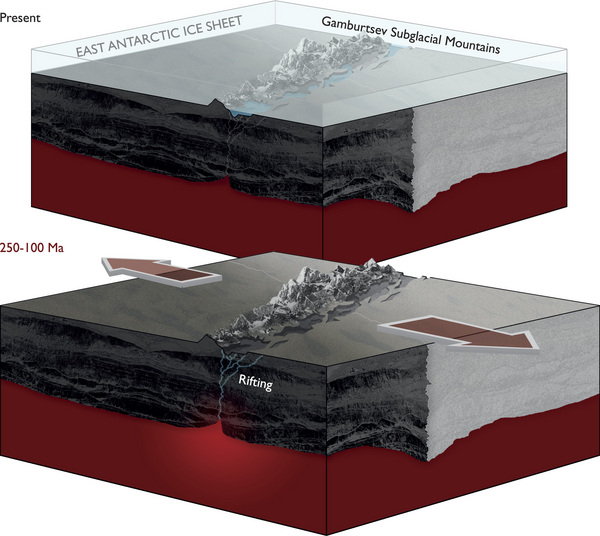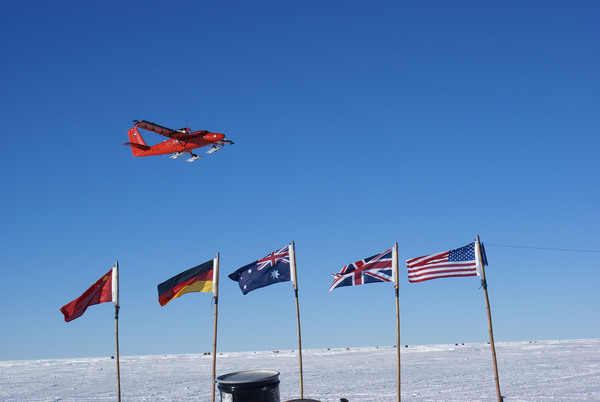
Light Shed on Origin of Antarctica's Buried Mountains

The origins of a mysterious range of Antarctic mountains completely hidden under the continent's massive ice sheet might now be coming to light, researchers now reveal.
The Gamburtsev Subglacial Mountains in East Antarctica rise up to 10,000 feet (3,000 meters) above the planet's surface, but are covered by up to 15,750 feet (4,800 m) of ice. This icy coat makes them "the least understood mountain range on Earth,"Fausto Ferraccioli, a geophysicist at the British Antarctic Survey and researcher on a new effort to better understand the mountains, told OurAmazingPlanet.
"It is very fitting that the initial results of Antarctica's Gamburtsev Province project are coming out 100 years after the great explorers raced to the South Pole," said Alexandra Isern, program director at the National Science Foundation. "The scientific explorers of the Antarctica's Gamburtsev Province project worked in harsh conditionsto collect the data and detailed images of this major mountain range under the East Antarctic Ice Sheet. The results of their work will guide research in this region for many years to come."
Entombed mountains
What details scientists have uncovered about these mountains provide conflicting evidence about how they got there and how old they are. For instance, nearby rocks suggest they are quite ancient, but their steep, rugged shapes, which resemble the Alps, are what one would expect of young mountains.
To learn more about the origins of these enigmatic peaks, researchers collected new data from the Gamburtsev region with two aircraft equipped with ice-penetrating radars, lasers and magnetic and gravity meters. They flew approximately 74,500 miles (120,000 kilometers) for their research, which Ferraccioli said is "like going around the world three times."
Magnetic anomalies seen throughout the Gamburtsevs match those of approximately 1-billion-year-old rocks seen to the north, ones predating the evolution of animals and plants on Earth. This evidence suggests the root of this mountain range was born around that time from collisions of several continents or microcontinents, findings corroborated by gravity and other data.
Sign up for the Live Science daily newsletter now
Get the world’s most fascinating discoveries delivered straight to your inbox.

The research then suggests that rifting events about 250 million years ago and 100 million years ago, back when dinosaurs roamed the Earth, triggered the uplift of these mountains. Specifically, the rise of rock along the flanks of these rifts and the buoyant root of these mountains forced the land upward. Rivers and glaciers then cut deep valleys, giving these mountains their rugged shapes. The East Antarctic Ice Sheet, which currently covers one-tenth of Earth's crust, then entombed the range, preserving them as they are today.
Next steps
"Explorers that set foot on the moon for the first time were confronted with many unknowns and challenges — the same holds true for the Gamburtsevs, in my view," Ferraccioli said. "Unraveling the mystery of how the mountains formed by analyzing the new data and putting together bits and pieces of a billion-year history of the region was really exciting." [Images: Scientists at the End of the Earth]
"Although I am happy that we have learnt quite a lot from the new data, I am well aware that the challenges are far from finished, and refining our interpretations and testing our ideas will require more work," Ferraccioli added. Still, "I believe that our new geophysical images and models will help guide future research on geological evolution and mountain-building in this remote region for years to come."
The next step "will be to assemble a team to drill through the ice into the mountains to obtain the first rock samples from the Gamburtsevs," said researcher Robin Bell of Columbia University's Lamont-Doherty Earth Observatory. "Amazingly, we have samples of the moon but none of the Gamburtsevs. With these rock samples, we will be able to constrain when this ancient piece of crust was rejuvenated and grew to a magnificent mountain range."
The scientists detailed their findings in the Nov. 17 issue of the journal Nature.
This story was provided by OurAmazingPlanet , a sister site to LiveScience.










